Gold coins have long been symbols of wealth, power, and history, capturing the imagination of collectors and investors alike. Certain gold coins have transcended their monetary value throughout the centuries, becoming rare treasures due to their unique stories, historical significance, or sheer scarcity.
We list the 10 rarest and most expensive gold coins below, along with their fascinating history, which is undoubtedly why they are coveted by numismatists and collectors worldwide.
1879 $4 Coiled Hair Stella Gold Coin
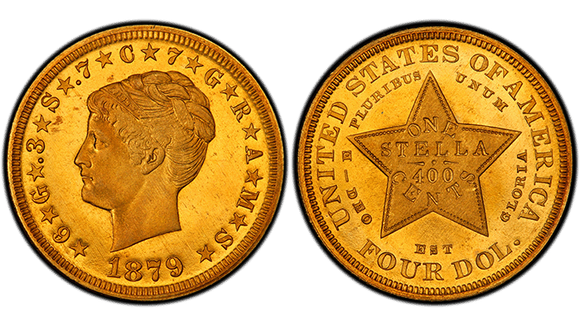
Value: $1.04 million
The 1879 $4 Coiled Hair Stella is one of the rarest and most storied coins in U.S. numismatic history. It was part of a short-lived attempt by the United States to create an internationally recognized currency that would facilitate trade with Europe, whose countries were adopting the Latin Monetary Union.
This alliance, formed in 1865 by several leading economic powers of the time, introduced a unified standard for the weight and purity of gold and silver coins, facilitating their free circulation and simplifying trade across Continental Europe. Officially lasting until 1927, the union served as a precursor to the modern European Union.
American travellers observed how easily currency could be exchanged within the union, in stark contrast to the challenges they faced when converting U.S. coins. These difficulties sparked multiple efforts to align the American gold coinage system with the standards set by the Latin Monetary Union.
The $4 denomination was chosen for the Stella because it closely aligned with the value of key European gold coins under the Latin Monetary Union, such as the French 20-franc coin, the Dutch 8-florin, the Spanish 20-peseta, and the Italian 20-lire.
The $4 coin, nicknamed the “Stella,” was named after the five-pointed star on its reverse side, which prominently featured the Latin word “stella”, meaning “star.” The Coiled Hair Stella, designed by U.S. Mint engraver George T. Morgan, is distinct from its Flowing Hair counterpart due to its more intricate depiction of Lady Liberty’s hair, coiled into a tight bun. Only a few dozen Coiled Hair Stellas were struck, making them incredibly rare.
The coin’s rarity is further underscored by the fact that the Stella project was never officially adopted. Congress ultimately abandoned the idea of the $4 coin after producing only a limited number of 1879 and 1880 Stellas as pattern coins. Many of these coins were distributed to lawmakers, while a select few made their way into private hands.
Over time, the Coiled Hair Stella became a coveted collector’s item, sought after not only for its rarity but also for its connection to an ambitious but short-lived chapter in U.S. minting history. Its intricate design and historical significance cemented its status as one of the most desirable coins among numismatists.
In 2017, a Proof-66 Cameo 1879 $4 Coiled Hair Stella gold coin was sold by David Lawrence Rare Coins for just over $1 million to a client by private treaty. The coin was graded by the Professional Coin Grading Service (PGCS).
1829 $5 Capped Head Left Half Eagle
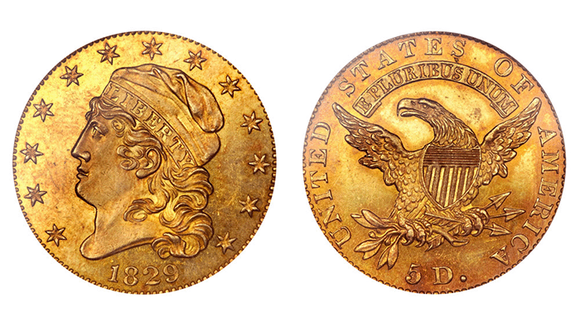
Value: $2.88 million
Designed by Chief Engraver William Kneass, the 1829 $5 Capped Head Left Half Eagle features a portrait of Lady Liberty wearing a cap inscribed with the word “LIBERTY,” facing left, and an eagle with a shield on the reverse. Part of the Capped Head series minted from 1813 to 1834, the 1829 Half Eagle was produced in extremely limited quantities due to changes in U.S. coinage laws and minting practices.
Advances in minting technology at the United States Mint in 1829 led to a redesign of the coin’s diameter and the introduction of a “close collar” method, which gave coins a more uniform edge and size. This technology transition resulted in two distinct designs of the 1829 $5 Capped Head Left Half Eagle gold coin for the year: a Large Diameter, Large Date coin struck by the old open collar, and a new Reduced Diameter, Small Date coin struck using close collar.
With the open collar, coin strikes were often not precisely centered given that the planchets were not held tightly by the collar, resulting in slightly uneven dentils around the coin’s circumference. Conversely, the close collar method restricted planchet movement and expansion during striking, producing perfectly centered coins with a uniform reeded edge and raised rim.
Mint records indicate that a significant total of 57,442 Capped Bust Left half eagles were minted in 1829, divided between the two design variations. The rarity of both the Large and Small Diameter varieties was such that early numismatists lacked the chance to examine and compare examples of the two types side by side.
Awareness of the two variations became more widespread during the 1880s, as advanced research into die varieties was conducted by numismatists such as John W. Haseltine and John Colvin Randall.
In 2023, the 1829 $5 Capped Head Large Diameter Left Half Eagle gold coin was sold for a record $2.88 million in an auction of the Harry W. Bass Jr. Core Collection. It was graded Proof 66+ by Professional Coin Grading Service is the finer of just two Proof examples known. The second coin, certified as Proof 64 by PCGS, was last auctioned over a decade ago, fetching $1.38 million at the time.
Big Maple Leaf
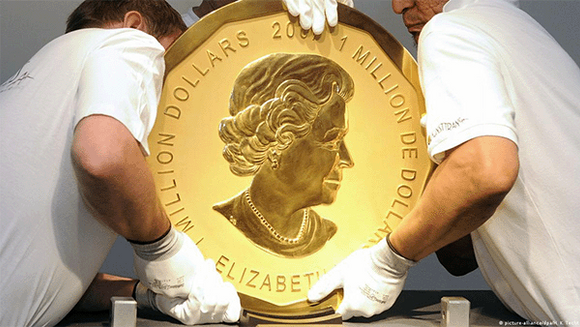
Value: $4 million
The 100 kg Big Maple Leaf gold coin, minted by the Royal Canadian Mint in 2007, stands as one of the rarest, most valuable and largest gold coins in the world. Crafted from 99.999% pure gold, it weighs 100 kilograms (220 pounds) and measures 53 centimeters in diameter.
The coin features the iconic Canadian maple leaf on one side and an effigy of Queen Elizabeth II on the other, showcasing the Mint’s exceptional artistry and precision. The Big Maple Leaf gold coin was the first 100 kg coin to have 999.99 fineness.
With a face value of $1 million CAD, its actual gold content is worth far more, reflecting its immense intrinsic and collectible value.
The Royal Canadian Mint created the Big Maple Leaf to showcase its leadership in gold refining and coin manufacturing. At the time of its minting, it set a world record for the largest gold coin, underlining the Mint’s ability to produce exceptional pieces of numismatic and technical brilliance.
Initially conceived as a one-off showpiece, several investors’ interest led to the production of five additional coins, bringing the total number of Big Maple Leafs to just six.
In 2010, one Big Maple Leaf coin was purchased by a private investor and loaned to Berlin’s Bode Museum. It was famously stolen in 2017 by thieves and was never recovered despite the perpetrators being convicted a year later.
723 AD Umayyad Gold Dinar
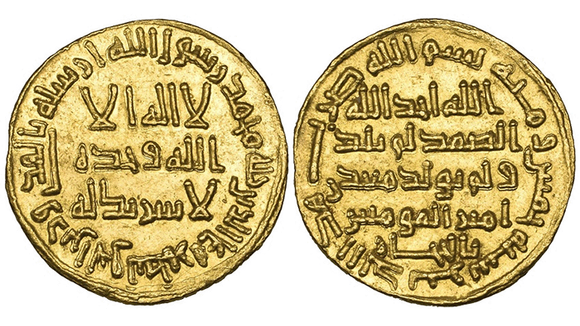
Value: $4.76 million
The Umayyad Caliphate, established in 661 AD by Caliph Muawiya I following the First Islamic Civil War, was one of the earliest and most influential Islamic empires. Centered in Damascus, Syria, it played a key role in the development of the early Islamic world, significantly expanding its territory across North Africa, the Middle East, and Spain. The Umayyads were instrumental in spreading Islamic culture and governance across these regions during their rule until 750 AD.
For the caliphs, it was unthinkable that the prosperous Umayyad Caliphate lacked its own distinct currency, especially since state matters and daily transactions were carried out using Byzantine coins or replicas, which featured Christian symbols and images of foreign rulers.
The 723 AD Umayyad Gold Dinar, also known as the Hisham Gold Dinar, is a historically significant coin minted during Caliph Hisham’s reign in the late 7th century. Struck in gold, the coin was part of the early Islamic monetary system and is considered one of the first coins to feature Arabic inscriptions rather than traditional images of rulers or deities, reflecting the Islamic prohibition on such depictions.
The coin’s obverse bears an inscription of the Shahada, the Islamic declaration of faith, along with the name of the caliph and the year of minting. The reverse features the inscription “Ma’din Amir al-Mu’minin”, meaning Commander of the Faithful. Its design marked a key departure from the coinage traditions of previous empires, aligning with the religious and cultural shifts of the time.
In 2019, a 723 AD Umayyad Gold Dinar was sold at an auction executed by Morton & Eden for a record $4.76 million.
1870-S $3 Gold Coin
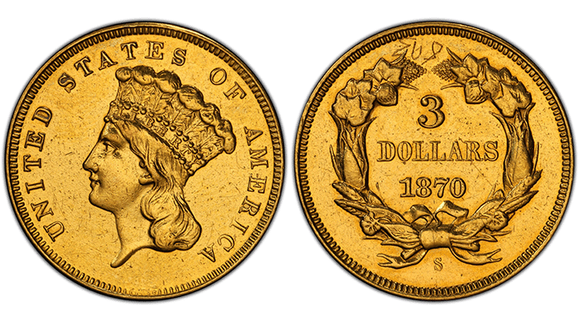
Value: $5.25 million
The story of the 1870-S $3 Gold Coin begins with the construction of the San Francisco Mint, also known as the “Granite Lady.” To commemorate the establishment of the new mint, the U.S. Mint produced special presentation coins, including the $3 gold piece, with the “S” mintmark signifying San Francisco.
According to historical records, a single 1870-S $3 coin was placed in a time capsule with other items in a cavity in the foundation below the cornerstone of the San Francisco Mint during a ceremonial event on May 25, 1870, celebrating the laying of the cornerstone.
The event was organized by various Masonic lodges from the area, adhering to the longstanding customs of their fraternity. The occasion featured a magnificent parade, with military bands and hundreds of Masonic leaders dressed in full ceremonial attire making their way from the Masonic Temple to the site of construction.
The purpose of laying the time capsule (a.k.a casket) is understood from the words of Grand Master Leonidas E. Pratt, published in a local newspaper covering the event, who was invited to lay the cornerstone:
“… it has ever been the custom of the Craft upon occasions like the present, to deposit within a cavity in the stone placed at the northeast corner of the edifice, certain memorials of the period at which it was erected; so that if, in the lapse of ages, the fury of the elements, the violence of man, or the slow but certain ravages of time, should lay bare its foundations, an enduring record may be found by succeeding generations, to bear testimony to the untiring, unending industry of the Free and Accepted Masons.”
What was also interesting about the 1870-S $3 coin was that it was initially struck without the mintmarks on the reverse dies, a detail overlooked by the Philadelphia Mint until the cornerstone ceremony was imminent. According to communication between the Philadelphia Mint and the San Francisco Mint, the dies and 2000 coins, $1 and $3 denominations, without the mintmark were rejected by Mint Director James Pollock.
He instructed the Philadelphia Mint to correct the dies by including the “S” mintmark and to send new dies “by express” to the San Francisco Mint in time for the ceremony. Given that the new dies were expected to arrive only within days of the ceremony, San Francisco Mint Chief Coiner Joseph B. Harmstead proceeded to cut the mintmark into the $3 die by hand.
The 1870-S $3 gold coin stands out not only for its unique mintmark among San Francisco coins but also for the rare distinction of possibly being the only branch mint coin of any kind to have its official mintmark applied directly at the branch mint rather than at the main Philadelphia Mint.
In a 1911 public auction, an 1870-S $3 gold coin appeared wrapped in a piece of yellow paper with the following words:
“This Three Dollar piece is a duplicate of the one under the cornerstone of the San Francisco Mint and the only one in existence. J.B. Harmstead.”
While the auctioneer claimed that the coin originated with Harmstead’s family, it is unknown under what circumstances a second piece of the 1870-S $3 gold coin was struck.
The Harmstead coin is believed to be used as a pocket coin with clear signs of being removed from a jewelry mount at 6 o’clock on the obverse and the numerals “893” scratched on the reverse.
This duplicate 1870-S $3 gold coin was sold at the 1911 auction for $1,450. In 2023, the gold coin sold for a record $5.25 million from the Harry W Bass, Jr. Core Collection.
Renowned numismatic expert Q. David Bowers likened possessing the 1870-S $3 gold coin to owning the Mona Lisa, as both are unique masterpieces of such immense value that their worth cannot be measured.
1804 $10 Draped Bust Gold Eagle
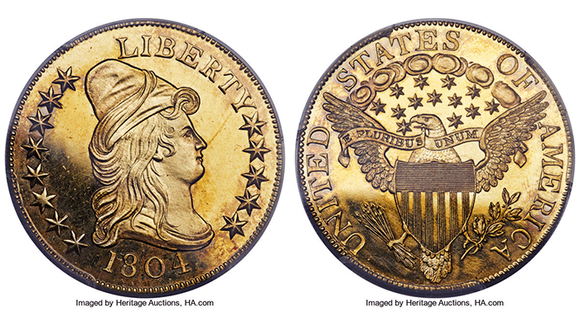
Value: $5.28 million
The Draped Bust Gold Eagle, first introduced in 1795, was the largest gold denomination authorized by the Coinage Act of 1792, with a face value of $10. It was also known as “Capped Bust” or “Turban Head.”
Designed by United States Mint engraver Robert Scot, the coin's obverse features a bust of Lady Liberty facing right, wearing a Phrygian cap with strands of her hair wrapped around it and also flowing to her shoulder. Thirteen stars, divided into eight on the left and five on the right, appear on either side of Liberty’s capped bust.
The reverse depicts a heraldic eagle, based on the Great Seal of the United States, with a shield against its breast, clutching arrows, and an olive branch, symbolizing strength and peace. However, the arrows and olive branch positions are reversed compared to the Great Seal. It has been speculated that this change symbolized defiant militarism, deemed apt given that the United States was engaged in a naval war with France then. The heraldic eagle design was introduced in 1797 and was used until the end of the series in 1804.
Between 1795 and 1797, a different reverse design was used, featuring a small eagle with its wings spread, holding an olive wreath in its beak. Regardless, both designs had the same Draped Bust Liberty on the obverse. No denomination was indicated on the Capped Bust Gold Eagle gold coin, a practice similar to other early United States gold coinage.
The mintage of the Capped Bust Gold Eagle remained low throughout its production due to limited gold deposits and people's preference for lower denomination coins for practical use.
Another factor that eventually impacted its mintage was the 1:15 gold-silver ratio in the United States, which was lower than that in foreign countries. Exchanging one ounce of U.S. gold for 16 or more ounces of foreign silver became a lucrative opportunity. By using 15 of those silver ounces to acquire another ounce of U.S. gold, traders could pocket a surplus of one ounce of silver as profit. The outcome was inevitable—U.S. gold coins vanished from circulation, remaining only in bank vaults or in the possession of wealthy individuals who had the means to retain them as cherished assets.
Finally, in 1804, newly elected President Thomas Jefferson halted the production of gold eagles to stem the flow of gold from the U.S.
In the mid-1830s, the United States aimed to negotiate favorable trade agreements with various nations in Southeast Asia and the Middle East. To achieve this, Edmund Roberts was appointed as a special envoy to facilitate treaty discussions with targeted countries in the region. The diplomatic customs of the era required an exchange of gifts between negotiating parties. In response, an extensive collection of luxury items was curated for the King of Siam, the Sultan of Muscat, and the Emperors of Cochin China and Japan. These bespoke gifts included maps, pistols, clocks, telescopes, cut glassware, and other examples of exceptional American craftsmanship.
Each set also featured a boxed collection of premium-quality U.S. proof coins. Newly struck gold eagles and silver dollars, dated 1804, were decided to be included in this box of proof coins. Although these gold eagles, struck in the 1830s, bore the 1804 date, they differed in that their 1804 date had a plain ‘4’ typography instead of the crosslet ‘4’ of the earlier coins.
Since only four pieces of the plain ‘4’ Draped Bust $10 Gold Eagle coins were minted as diplomatic mission gifts, they are significantly rarer than their crosslet ‘4’ counterparts. In 2021, an 1804 Plain ‘4’ Draped Bust Gold Eagle was sold at an auction for a record $5.28 million.
1861 Coronet, Paquet Reverse gold $20 double eagle
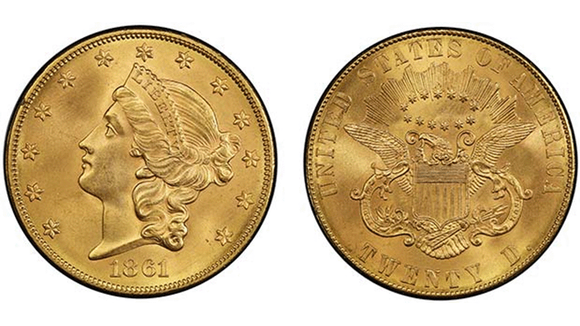
Value: $7.2 million
The 1861 Coronet, Paquet Reverse gold $20 Double Eagle, minted during the tumultuous early days of the American Civil War, holds a unique place due to its distinctive reverse design and extreme rarity.
The gold coin’s obverse features a left-facing bust of Liberty with her hair tied in a bun behind her head, wearing a coronet inscribed with ‘LIBERTY.’ Encircling the design are 13 six-pointed stars, with the date positioned beneath the portrait. The neck truncation bears the engraved initials JBL, representing James Barton Longacre, the Chief Engraver at the Philadelphia Mint.
Longacre initially designed the reverse of the Coronet $20 Gold Double Eagles struck in the 1850s, but many reverse dies cracked during the striking process. Numismatic scholar Q. David Bowers believes this issue may have led to Assistant Engraver Anthony C. Paquet redesigning the reverse of the double eagle beginning in 1859.
Among several of Paquet’s modifications to the reverse of the standard Coronet Double Eagle coin, the most notable changes were thinner borders, taller and thinner letter font, and a lower arrangement of stars above the eagle that kept clear of the rays. This design was intended to improve the striking process and enhance the coin’s visual appeal. Additionally, dies of this first reverse design for minting at the San Francisco Mint had an ‘S’ mintmark, below the eagle’s tail.
The dies for this new design were shipped to the San Francisco Mint in November 1860 in preparation for striking and releasing these gold coins into circulation. Similar dies were also sent to the New Orleans Mint in December.
However, Paquet’s reverse design had mismatched borders with the obverse, and this difference caused striking problems that could only be mitigated by adjusting the milling, a process requiring additional tinkering time.
Given that the Philadelphia Mint was required to strike a high mintage for the Liberty Twenties in 1861, the added time to adjust the mill to accommodate the new reverse design slowed the Mint’s output. In his attempt to remedy this issue, Mint Director James Ross Snowden suspended coinage with Paquet’s reverse on January 5th at the Philadelphia Mint and reverted to the use of Longacre’s reverse dies. Despite minting more than 2.9 million coins with Paquet’s reverse design up to that point, all were melted in preparation for re-striking the coins.
Snowden promptly sent telegrams to inform the New Orleans and San Francisco Mint of the change. The New Orleans Mint received the telegram before any double eagles were struck, but it took much longer for the San Francisco Mint to be notified. Snowden’s telegram was sent, as far as transcontinental telegraph lines were completed, to St. Louis, Missouri, and had to be delivered overland the rest of the way.
By the time the San Francisco Mint received the message, they had struck 19,250 ‘Paquet reverse’ double eagles, which were released into circulation and impractical to recall. These coins, often called 1861-S Paquet Reverse gold double eagles, saw extensive use in international and domestic commerce, enduring significant wear and loss over time. Collectors of the era did not preserve these coins, and no examples in Mint State (MS) condition have been authenticated to date.
Today, only 2 Philadelphia-minted "Paquet Reverse" coins are known to exist, both of which were struck with a second design of the reverse by Paquet. There are no Mint records about the development of this second design or its mintage. Since both coins were minted at the Philadelphia Mint, they do not have a mintmark. The second design also had minor adjustments to the central design elements’ placement, such as wider spacing between letters of the denomination and the placement of the eagle and stars.
In 2021, an MS-67-graded 1861 Coronet, Paquet Reverse gold $20 double eagle sold for $7.2 million at an American Numismatic Association (ANA) auction.
1822 $5 Capped Bust Half Gold Eagle
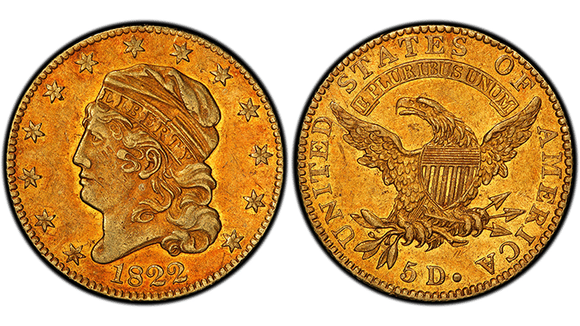
Value: $8.4 million
Often described as ‘an American treasure’ or even ‘legendary,’ the 1822 Half Eagle is a renowned piece of American history and is often considered a key gold coin to completing a whole collection of U.S. coinage.
Only three pieces of the 1822 Capped Bust Half Gold Eagle are known to exist today despite a reported mintage of 17,796. Two pieces are permanently impounded in the National Numismatic Collection at the Smithsonian Institution, while the third gold coin remains in private hands – the only piece available for purchase. This is how rare the 1822 Half Gold Eagle is today.
How a considerable mintage was dwindled to only three existing coins remains a mystery. Numismatists have theorized that the lower U.S. gold-silver ratio in the 19th century led to many gold coins being shipped overseas due to the effect of Gresham’s Law, where they were subsequently melted for foreign coinage.
One of the three surviving Half Gold Eagles had its chain of custody traced to Harlan Paige Smith's purchase from a bullion dealer’s inventory for just $6.50 in the late 1890s. This was undoubtedly one of history’s greatest gold coin purchases.
An 1822 Half Eagle gold coin, bearing a $5 face value, was auctioned from the D. Brent Pogue Collection for $8.4 million in Las Vegas in 2021, setting a new record as the most valuable gold coin ever sold at auction, as reported by Stack’s Bowers Galleries.
Brasher Doubloon
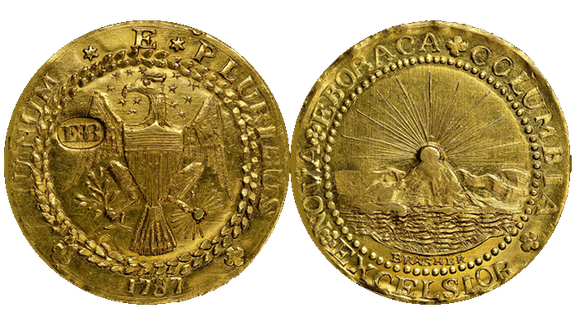
Value: $9.36 million
Struck in 1787 by Ephraim Brasher, a skilled New York goldsmith and silversmith, the Brasher Doubloon is widely regarded as the first gold coin minted in the United States.
Brasher was a respected figure in colonial New York, known for his high-quality silverware. He inspected and verified the fineness and weight of precious metal coins for the bank, ensuring they met the required standards. If the coins passed his evaluation, he stamped them with his oval hallmark featuring his initials, "EB," as a mark of assurance. This hallmark became a trusted symbol of quality, allowing bank clerks to accept coins without re-weighing them. Over time, numerous foreign gold coins bearing his quality stamp have been uncovered.
As the young United States struggled with a lack of uniform currency in the post-Revolutionary War era, Brasher took it upon himself to mint gold coins of consistent weight and purity.
The doubloon features Brasher's hallmark craftsmanship, with one side depicting the Great Seal of the United States, an eagle holding an olive branch and arrows. It is encircled by an unusually worded state motto of New York, "Unum E Pluribus" (One, Out of Many).
The other side displays a sun rising over a mountain, accompanied by the words “Nova Eboraca Columbia Excelsior’ meaning “New York, America, Ever Higher.” Brasher’s last name can be seen under the mountain image. Brasher Doubloons, with this mountain image, has been called “New York Style” because of its design similarity with the New York State seal.
Two other “Lima Style” Brasher Doubloons are known to exist. The coins were aptly named because of their design, which mirrored Spanish gold coins.
Brasher struck the coins using gold likely sourced from Spanish doubloons circulating at the time, making them a hybrid of New World craftsmanship and Old World resources. All seven known examples were stamped by Brasher with a punch bearing his initials, "EB," enclosed in an oval. On one specimen, the mark is positioned on the shield at the center of the eagle, while on the others, it is placed on the eagle's right wing.
In 2021, an NGC-graded MS-65 1787 ‘EB’ on Wing New York Style Brasher Doubloon was sold for a record price of $9.36 million.
1933 $20 Double Eagle
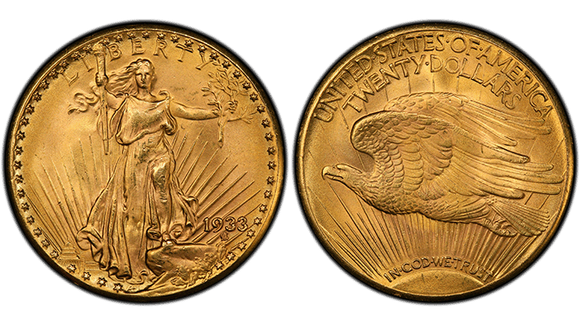
Value: $18.9 million
The 1933 Double Eagle is a $20 gold coin designed by the renowned sculptor Augustus Saint-Gaudens, whose work is considered among the most beautiful in U.S. numismatics. However, its rarity stems not from its design but from the historical context in which it was minted and the dramatic sequence of events that followed. The 1933 Double Eagle was the last gold coin struck for circulation in the United States.
In 1933, during the Great Depression, President Franklin D. Roosevelt issued Executive Order 6102, effectively banning the private ownership of gold to stabilize the economy and end the hoarding of gold. This order marked the United States' departure from the gold standard. The President also signed Proclamation 2039, which prohibited the use of gold for payments, as well as the hoarding and export of gold coins or bullion.
Consequently, the U.S. Mint had already produced a limited run of 445,500 Double Eagles in 1933 but never officially released them into circulation. As a result of the Executive Order, the Mint melted almost all of these coins down into gold bars in 1937.
Despite the confiscation order, a small number of 1933 Double Eagles escaped destruction—possibly through illicit means involving Mint employees. The United States Mint would not know these coins for the next seven years. They quickly became the subject of intense government scrutiny, with the U.S. Secret Service spending decades tracking down and recovering examples.
One coin, the first to surface publicly in private hands, was purchased by King Farouk of Egypt in 1944 for $1,575. Due to Proclamation 2039, an Egyptian diplomat applied for an export license for the coin with the Treasury Department in 1944. As the 1933 Double Eagle was declared a rare collectable, the Treasury Department consulted with the National Numismatic Collection curator. However, the curator was only aware that the U.S. Mint sent two of these coins to the Smithsonian for collection but was unaware that the coin was never officially issued. With no red flags detected, the Secretary of the Treasury granted the export license. This 1933 Double Eagle promptly left U.S. shores and came into The Egyptian King’s possession.
After King Farouk was deposed in 1952, the Egyptian government auctioned off his possessions, including his famous coin collection. The 1933 Double Eagle was listed in the catalog for this auction, described simply as a "U.S. $20 gold coin, 1933." However, the U.S. government had by then realized the significance of the coin and demanded its return. In response to their request, the coin mysteriously disappeared from the auction and was not seen again for decades.
The coin resurfaced in the 1990s when British coin dealer Stephen Fenton brought it to light. This triggered a lengthy legal battle between Fenton and the U.S. government, which ended with a unique settlement in 2001. The government agreed to legalize Fenton’s coin, making it the only 1933 Double Eagle that can be privately owned. This coin was sold at auction in 2002 for $7.59 million and again in 2021 for $18.9 million, making it the most expensive gold coin in the world.
In 2004, ten 1933 Double Eagles were discovered by Joan Langbord, the daughter of Philadelphia jeweler Israel Switt, who was suspected of acquiring the coins through improper means during the 1930s. Langbord claimed the coins were part of her late father’s estate and turned them over to the U.S. Mint for authentication. However, the federal government seized the coins, arguing that they had been unlawfully removed from the Mint and were thus government property. This led to a lengthy legal battle between the Langbord family and the government, with the case going through various courts over several years. Ultimately, in 2017, the U.S. Supreme Court declined to hear the case, effectively upholding a lower court ruling that awarded ownership of the coins to the government. The ten coins now remain in the custody of the U.S. Treasury.
